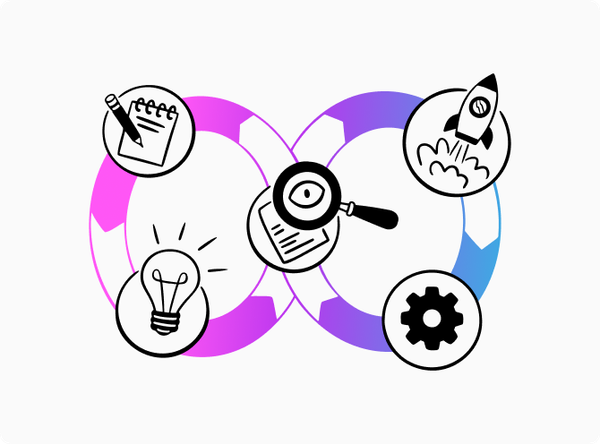
In today’s fast-paced business world, entrepreneurs and startups face pressure to develop and launch innovative products quickly to stay ahead of the competition. This is where the implementation of MVPs becomes crucial. With just enough features to satisfy early adopters, an MVP allows companies to test the waters and speed up product development.
So how do you develop an MVP that is successful and can generate revenue? The best thing to do would be to turn to real-life examples of MVPs and draw inspiration from them.
In this article, we will discuss 12 minimum viable product examples in 2023 across various industries. This will help you get a better grasp of what an MVP is and how it can be leveraged to create a successful business.

Are All MVP Projects Successful
MVPs are often seen as the key to success, and it’s certainly true. By creating a product with a minimum set of features, businesses are able to quickly gather user feedback and save money that would otherwise be spent on building a full-scale product that nobody needs. However, not all MVP projects are successful, and many fail to achieve their goals.
About 305 million new startups get launched globally every year. At the same time, market research statistics show that a significant number of these startups fail even before they are ready to test their products. In fact, only 1 out of 10 startups will make it past the MVP stage, and only 1 out of 100 startups will achieve significant success.
Why is this happening? And what are the common reasons that lead to the failure of an MVP project?
Among the main reasons for failure are a lack of market research and an insufficient level of customer validation. Many startups make the mistake of assuming that there is a demand for their product, without actually testing the market first. Without careful assessment of the market, startups risk building products that nobody wants or needs, resulting in wasted time and resources.
Another common reason why MVPs fail is due to poor execution. While the idea behind an MVP may be sound, the execution can often be flawed. This could be either due to a lack of technical expertise, poor project management, or simply a lack of resources. Thus, building a successful MVP project requires a strong team with a diverse range of skills and expertise.
Of course, the success of an MVP doesn’t rely solely on the team’s effort. There are a number of external factors that can have an impact on the success of a project, such as:
- Market conditions;
- Competition;
- Luck (that’s right).
Even though these factors may get in the way of any company, how the team approaches them is what can make the difference. Further in the article, we’ll discover real-life MVP entrepreneurship examples that not only didn’t fail but have actually reached amazing scales and earned worldwide fame.

12 Successful MVP Examples
We could elaborate on the importance of an MVP for prototype development, but lean startup MVP examples speak louder than words. To help you gain valuable insights into the MVP development process and learn how to apply these principles to your own project, we’ve put together a list of the best MVP examples from which to draw inspiration.
1. Airbnb
Airbnb, one of the most successful startup MVP examples to date, launched in 2008 as nothing more than a single-page website. The idea to create this project came to product designers when they realized that they could not maintain their apartment and decided to earn extra money by renting it out.
After setting up a simple website and uploading a few photos of their place, they not only found their first guests almost immediately but saw huge demand for the service, giving them the green light to scale up. Today, Airbnb has over 7 million listings worldwide and is valued at $80+ billion.
2. Uber
Uber is another example of a worldwide company that started out as a simple MVP first. The purpose of the app was to connect passengers with drivers, as well as to make traveling more comfortable and affordable for them.
By focusing on a simple, intuitive user experience, Uber was able to quickly gain traction and disrupt the taxi industry. In 10 years’ time, the company has managed to increase its coverage to over 700 cities worldwide and has an estimated worth of over $80 billion.
3. Buffer
Another well-known MVP software example worth mentioning is Buffer. Joel Gascoigne, a founder of the company, started by creating a series of user-friendly landing pages. He wasn’t sure if his software would be successful, but the only way to find out was to see how people would engage with it, which he did by promoting his page on social media.
The positive reaction of people and the first signed-up forms told him that what he did was right and something that people want. Now, Buffer has transformed into a successful social media scheduling tool that has over 75,000 paying customers and generates over $20 million in annual revenue.
4. Canva
The story of Canva’s success is pretty simple. While the market continued to expand with new elaborate design tools, Sydney-based product designers chose a different path. Unlike the competition, they created a simple graphic design tool that had a wide range of templates and could be easily used even by non-designers. This was the key to their success.
Since 2013, when the company’s MVP was launched, it has grown immensely. Today, it has a loyal user base of over 55 million people worldwide, and has a valuation of over $15+ billion. It has also been recognized as one of the 50 most innovative companies in 2023, according to Fast Company.
5. Slack
It’d be remiss of us not to mention Slack, another example of an MVP product that is famous in the tech world for hitting the mark of $1 billion in just eight months without spending any money on ads or marketing campaigns. Starting as a simple messaging tool, Slack was able to quickly gain traction and become a staple for small and large teams worldwide.
Today, the software has over 10 million daily active users and a valuation of over $26.51 billion, making it the 661st of the most valuable companies in Market Cap’s list.
6. Mint
Among startup success stories, one that is definitely worth mentioning is the Mint app. This project started as a simple investment tracker but it very soon transformed into one of the most famous financial applications with the capacity to compile massive amounts of data from various banks, cards, and financial institutions all in one place.
It currently has over 20 million active users and remains one of the leading budgeting apps. Although there are many such apps, they are not anywhere close to Mint in terms of popularity.
7. HubSpot
You must have heard of HubSpot. However, did you know that what we know now as one of the biggest CRM that businesses use to drive sales started as a simple blog? By creating a product that focused on content marketing and lead generation, HubSpot was able to quickly gather user feedback, which encouraged them to create a CRM platform. Now, this platform has over 100,000 customers and a valuation of over $10 billion, which isn’t a small feat.
8. Basecamp
Another great minimum viable product that became a huge success is Basecamp. The unique thing about this solution is that it was designed internally to solve the problem of a team that was looking for other ways than email to handle projects.
However, the many great features and conveniences that Basecamp offered allowed it to scale and grow into one of the best project management tools we know today. In 2023, Basecamp’s loyal user base reached over 3 million, with 2,500 more signups every week.
9. Waze
While there were already many navigation apps, the concept of Waze was quite new. Unlike their peers, the founders of Waze approached navigation differently and rather than just providing maps, used crowdsourced data, which allowed them to provide real-time traffic information.
To a large extent, Waze’s success came from its ability to build a strong community of users who were passionate about the product. As more users joined the platform, the accuracy of the data shared in the app increased, further improving the product. Today, Waze has over 130 million active users worldwide and is a leading navigation app.
10. Square
Square is a relatively young MVP software example that has paved its way to success in a short while. Founded in 2009 by Jack Dorsey, the product started as a simple payment system with just a minimal set of features and a user-friendly interface. Today, it’s one of the major providers of software that companies in retail rely on to carry out transactions.
What sets Square apart from many other similar apps is that it can do a lot more than just take orders. It has evolved over time into a full-scale product with functionality to clock in employees, grant them permissions, and manage the customer directory in the app.
Additionally, transactions take considerably less time, as there’s no waiting for approval or receipt printing.
Presently, more than 1 million people actively use Square to handle transactions in the US alone, and this number is constantly growing.
11. Duolingo
A great example of how a minimum viable product became a success is Duolingo. Not only did the founders of this app decide early that the app shouldn’t cost anything, but they also made sure that learning with it was as fun as possible while offering value to users.
This helped them to build a vast base of users in just a few weeks. In fact, they already had over 10 million downloads in the first year, which goes to show that they achieved a product-market fit very quickly. Today, 12 years after its launch, the app has over 500 million users worldwide and a valuation of over $2 billion.
12. Grammarly
Our list of startup success stories and best MVP website examples wouldn’t be complete without Grammarly. Founded by Alex Shevchenko, Max Lytvyn, and Dima Lider, this app was initially aimed at helping students improve their writing and understand the learning blocks of the English language.
It very quickly attracted the attention of both users and investors because the concept behind the app was meant to be a success from its inception. Just 3 years after its creation, Grammarly was also introduced as a browser extension, resulting in a dramatic increase in average daily users.
Now the tool includes a wide range of functionality that goes far beyond a simple spell checker. However, it is only after people realize how great its features are that many of them switch to the paid version. With over 20 million daily active users and a valuation of over $1 billion, Grammarly is by far one of the best examples of MVP products and successful entrepreneurship.

Where to Look for Inspiration
Inspiration can be taken from anywhere, as long as you’re prepared to look around and be open to it. This is especially true for MVPs. New digital products emerge on the market at a phenomenal speed, which just proves the point. However, there are a few strategies that can help you out when you’re stuck for ideas. Here are some of them:
User feedback
One of the most effective approaches when it comes to finding inspiration is to conduct user testing. This includes gathering feedback and insights from potential customers, which can be done by:
- Going on a stream and directly talking to people;
- Using surveys;
- Joining open communities related to a product or service you want to create and engaging with participants to figure out their needs and pain points.
By understanding what people lack in the products or services that already exist and what their preferences are, entrepreneurs can translate those needs into MVPs that stand out in the marketplace.
Competition
Engaging with people is one way to find inspiration, but you should also keep a close eye on your competitors. Look at the products or services that are already offered and identify the features that are essential for solving the same problem. At the same time, you should also have a keen eye on the gaps in what they offer to understand how they can be filled with your MVP.
Industry trends
It goes without saying that in order to stay competitive in the market, it’s important to keep track of industry trends. What’s more, by attending conferences, reading newsletters, and following industry thought leaders on social media, you are more likely to come up with new ideas that will help build an outstanding MVP.
Industry events
By attending industry-related events, you can gain exposure to new technologies, tools, and trends that can help develop MVPs relevant to today's user needs and expectations. In addition to that, such events can also provide valuable networking opportunities.
You can meet people who are experts in the industry and gain insights from their knowledge. This can also include investors as well as potential customers who can share their experiences on the usage of other existing products and what could be done better in that regard.

How Lunka Can Help in Making MVP Projects
A great team is essential to being successful with an MVP. At Lunka.tech, not only do we have some of the best software developers who are well-versed in multiple languages including JavaScript, Node.Js, Python, React, Django, and Swift, but also those who are committed to what they do and focus on building long-term relationships with our clients. This allows us to precisely match the specific needs and goals of their projects.
Whether you are planning to develop a new app or website, but want to validate your idea with an MVP first, look no further than Lunka.tech. We have extensive expertise in creating MVPs for businesses in various industries, which you can see by visiting our portfolio. Also, we understand that every business is unique, and therefore, always stay abreast of the latest technologies to help realize your boldest ideas with smart solutions.
Final Thoughts
To sum it all up, building an MVP is the only right way to become successful in the tech world. It helps save you time and resources and allows you to pivot your product in the best possible direction based on the needs of your targeted audience.
The business case studies discussed in the article are a case in point. All known tech giants started out as simple MVPs, but because their MVPs were successful from their inception, they were destined to become industry leaders.
Want to be as successful as Uber or Airbnb? Or maybe you’re thinking about creating another navigation app that could predict not only traffic jams but also other road hazards? It’s more than doable. Contact us to discuss a customized solution!
FAQ
What are some examples of successful MVPs?
In addition to the examples of MVP presented in this article, it’d be worth mentioning such names as Instagram and Zappos. You might not have known but Instagram started as a simple check-in app (Burbn). When they tested the first version, they quickly realized that people were more interested in sharing photos and completely redesigned the app. In the case of Zappos, they basically did the same thing. Instead of investing money in opening a warehouse, the founders decided to start with a small inventory of shoes that they could store in their own apartments. This helped them determine if there was interest in the market and expand their service when they were ready.
Is it hard to create an MVP?
Depending on the complexity of your concept, creating an MVP may require expertise in various areas, such as software development, design, user experience, etc. However, with the right knowledge and a professional software development team, you will be able to minimize the development time and come up with the MVP version that meets the needs of your target audience.
How to build a successful MVP?
The key is to focus on a particular value that your MVP provides and work on the core features first. You need to also validate your idea before starting to work on the project, to make sure that you're working with a real user problem and not just some 'artificial' one. Another aspect is user feedback. After the MVP goes live, gather feedback from users, analyze usage data, and iterate on your product based on what you learn.
Where to draw inspiration when you’re stuck for MVP ideas?
Inspiration isn’t constant, and that’s totally fine. But you can certainly find ways to get a burst of inspiration by visiting various events and conferences, keeping track of industry trends, reading newsletters, analyzing reports, and of course, following in the footsteps of the world’s leaders.



